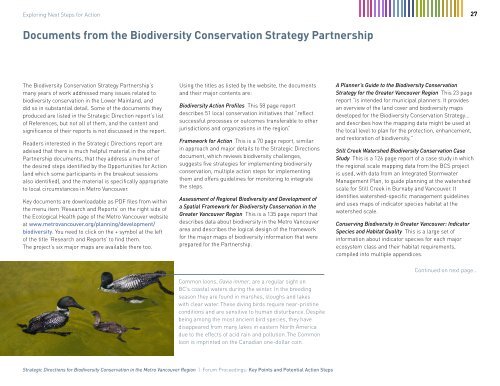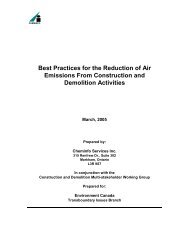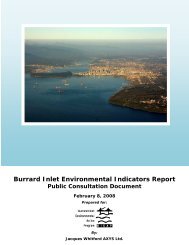Biodiversity Conservation - the BIEAP and FREMP Website
Biodiversity Conservation - the BIEAP and FREMP Website
Biodiversity Conservation - the BIEAP and FREMP Website
Create successful ePaper yourself
Turn your PDF publications into a flip-book with our unique Google optimized e-Paper software.
Exploring Next Steps for Action<br />
Documents from <strong>the</strong> <strong>Biodiversity</strong> <strong>Conservation</strong> Strategy Partnership<br />
The <strong>Biodiversity</strong> <strong>Conservation</strong> Strategy Partnership’s<br />
many years of work addressed many issues related to<br />
biodiversity conservation in <strong>the</strong> Lower Mainl<strong>and</strong>, <strong>and</strong><br />
did so in substantial detail. Some of <strong>the</strong> documents <strong>the</strong>y<br />
produced are listed in <strong>the</strong> Strategic Direction report’s list<br />
of References, but not all of <strong>the</strong>m, <strong>and</strong> <strong>the</strong> content <strong>and</strong><br />
significance of <strong>the</strong>ir reports is not discussed in <strong>the</strong> report.<br />
Readers interested in <strong>the</strong> Strategic Directions report are<br />
advised that <strong>the</strong>re is much helpful material in <strong>the</strong> o<strong>the</strong>r<br />
Partnership documents, that <strong>the</strong>y address a number of<br />
<strong>the</strong> desired steps identified by <strong>the</strong> Opportunities for Action<br />
(<strong>and</strong> which some participants in <strong>the</strong> breakout sessions<br />
also identified), <strong>and</strong> <strong>the</strong> material is specifically appropriate<br />
to local circumstances in Metro Vancouver.<br />
Key documents are downloadable as PDF files from within<br />
<strong>the</strong> menu item ‘Research <strong>and</strong> Reports’ on <strong>the</strong> right side of<br />
<strong>the</strong> Ecological Health page of <strong>the</strong> Metro Vancouver website<br />
at www.metrovancouver.org/planning/development/<br />
biodiversity. You need to click on <strong>the</strong> + symbol at <strong>the</strong> left<br />
of <strong>the</strong> title ‘Research <strong>and</strong> Reports’ to find <strong>the</strong>m.<br />
The project’s six major maps are available <strong>the</strong>re too.<br />
Using <strong>the</strong> titles as listed by <strong>the</strong> website, <strong>the</strong> documents<br />
<strong>and</strong> <strong>the</strong>ir major contents are:<br />
<strong>Biodiversity</strong> Action Profiles This 58 page report<br />
describes 51 local conservation initiatives that “reflect<br />
successful processes or outcomes transferable to o<strong>the</strong>r<br />
jurisdictions <strong>and</strong> organizations in <strong>the</strong> region.”<br />
Framework for Action This is a 70 page report, similar<br />
in approach <strong>and</strong> major details to <strong>the</strong> Strategic Directions<br />
document, which reviews biodiversity challenges,<br />
suggests five strategies for implementing biodiversity<br />
conservation, multiple action steps for implementing<br />
<strong>the</strong>m <strong>and</strong> offers guidelines for monitoring to integrate<br />
<strong>the</strong> steps.<br />
Assessment of Regional <strong>Biodiversity</strong> <strong>and</strong> Development of<br />
a Spatial Framework for <strong>Biodiversity</strong> <strong>Conservation</strong> in <strong>the</strong><br />
Greater Vancouver Region This is a 135 page report that<br />
describes data about biodiversity in <strong>the</strong> Metro Vancouver<br />
area <strong>and</strong> describes <strong>the</strong> logical design of <strong>the</strong> framework<br />
for <strong>the</strong> major maps of biodiversity information that were<br />
prepared for <strong>the</strong> Partnership.<br />
Common loons, Gavia immer, are a regular sight on<br />
BC’s coastal waters during <strong>the</strong> winter. In <strong>the</strong> breeding<br />
season <strong>the</strong>y are found in marshes, sloughs <strong>and</strong> lakes<br />
with clear water. These diving birds require near-pristine<br />
conditions <strong>and</strong> are sensitive to human disturbance. Despite<br />
being among <strong>the</strong> most ancient bird species, <strong>the</strong>y have<br />
disappeared from many lakes in eastern North America<br />
due to <strong>the</strong> effects of acid rain <strong>and</strong> pollution. The Common<br />
loon is imprinted on <strong>the</strong> Canadian one-dollar coin.<br />
Strategic Directions for <strong>Biodiversity</strong> <strong>Conservation</strong> in <strong>the</strong> Metro Vancouver Region | Forum Proceedings: Key Points <strong>and</strong> Potential Action Steps<br />
A Planner’s Guide to <strong>the</strong> <strong>Biodiversity</strong> <strong>Conservation</strong><br />
Strategy for <strong>the</strong> Greater Vancouver Region This 23 page<br />
report “is intended for municipal planners. It provides<br />
an overview of <strong>the</strong> l<strong>and</strong> cover <strong>and</strong> biodiversity maps<br />
developed for <strong>the</strong> <strong>Biodiversity</strong> <strong>Conservation</strong> Strategy…<br />
<strong>and</strong> describes how <strong>the</strong> mapping data might be used at<br />
<strong>the</strong> local level to plan for <strong>the</strong> protection, enhancement,<br />
<strong>and</strong> restoration of biodiversity.”<br />
Still Creek Watershed <strong>Biodiversity</strong> <strong>Conservation</strong> Case<br />
Study This is a 126 page report of a case study in which<br />
<strong>the</strong> regional scale mapping data from <strong>the</strong> BCS project<br />
is used, with data from an Integrated Stormwater<br />
Management Plan, to guide planning at <strong>the</strong> watershed<br />
scale for Still Creek in Burnaby <strong>and</strong> Vancouver. It<br />
identifies watershed-specific management guidelines<br />
<strong>and</strong> uses maps of indicator species habitat at <strong>the</strong><br />
watershed scale.<br />
Conserving <strong>Biodiversity</strong> in Greater Vancouver: Indicator<br />
Species <strong>and</strong> Habitat Quality This is a large set of<br />
information about indicator species for each major<br />
ecosystem class <strong>and</strong> <strong>the</strong>ir habitat requirements,<br />
compiled into multiple appendices.<br />
27<br />
Continued on next page…
















